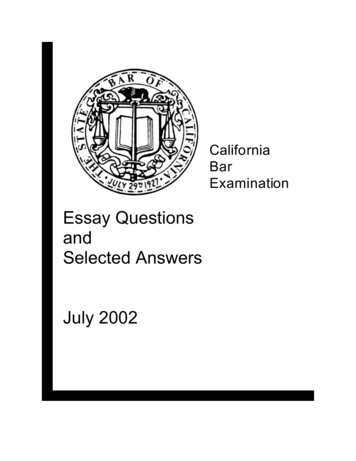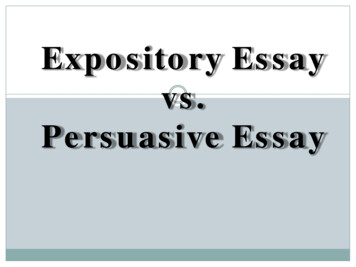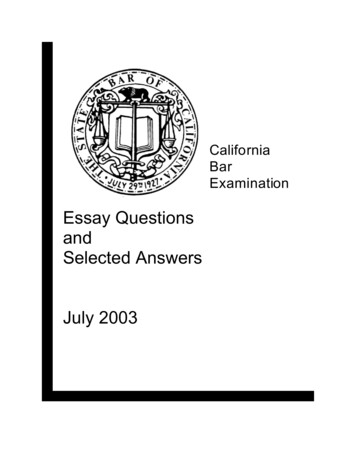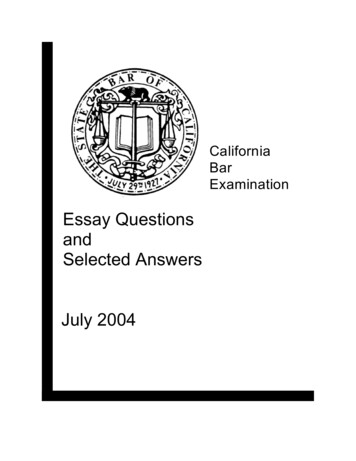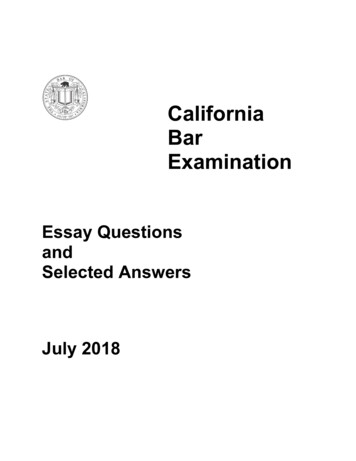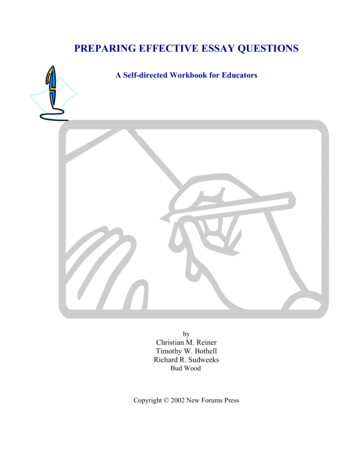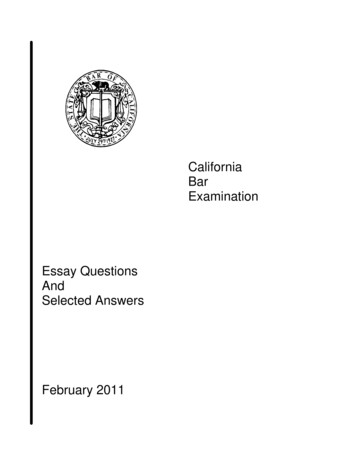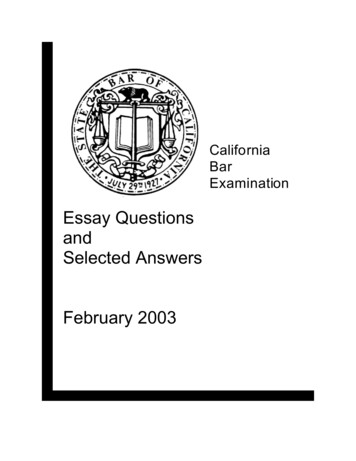
Transcription
CaliforniaBarExaminationEssay QuestionsandSelected AnswersFebruary 2003
ESSAY QUESTIONS AND SELECTED ANSWERSFEBRUARY 2003 CALIFORNIA BAR EXAMINATIONThis publication contains the six essay questions from the February 2003 CaliforniaBar Examination and two selected answers to each question.The answers received good grades and were written by applicants who passed theexamination. The answers were prepared by their authors, and were transcribedas submitted, except that minor corrections in spelling and punctuation were madefor ease in reading. The answers are reproduced here with the consent of theirauthors and may not be reprinted.Question NumberContents1.Civil Procedure2.Wills/Real Property3.Criminal Law & Procedure/Evidence4.Professional Responsibility5.Constitutional Law6.Community PropertyPage
CaliforniaBarExaminationAnswer all three questions.Time allotted: three hoursYour answer should demonstrate yourability to analyze the facts in question, totell the difference between material andimmaterial facts, and to discern the pointsof law and fact upon which the caseturns. Your answer should show that youknow and understand the pertinentprinciples and theories of law, theirqualifications and limitations, and theirrelationships to each other.Your answer should evidence yourabilityto apply law to the given facts and toreason in alogical,lawyer-likemanner from thepremises you adopt to a soundconclusion. Do not merely show thatyou remember legaliprinciples. Instead, try to demonstrateyour proficiency in using and applyingthem.If your answer contains only astatement of your conclusions, you willreceive little credit.State fully thereasons that support your conclusions,and discuss all points thoroughly.Your answer should be complete, butyou should not volunteer information ordiscuss legal doctrines which are notpertinent to the solution of the problem.Unless a question expressly asks you touse California law, you should answeraccording to legal theories and principlesof general application.
QUESTION 1Petra, a State W resident, recently patented a new design for a tamper-free bottle capfor soft drinks. She contracted with Dave, who lives in State X, to design amanufacturing process to mass-produce the newly patented bottle caps. Under thecontract, Dave was required to relocate to State W, where Petra had leased researchand development facilities, and to keep confidential all design and productioninformation concerning the bottle cap.Dave promptly found someone to rent his home in State X. He moved all his belongingsto State W. After working for six months in State W, Dave had perfected themanufacturing process, but when Petra denied Dave’s request for additionalcompensation he quit his job and disclosed the bottle cap manufacturing process toKola, Inc. (“Kola”).Kola is a regional soft drink bottler incorporated in State Y, with its principal place ofbusiness in State W. Kola flooded the market with bottled soft drinks capped with Kola’sversion of Petra’s bottle cap months before Petra could begin production.When Petra discovered what had happened, she filed suit against Dave and Kola instate court in State W for violation of State W’s patent infringement law. Petra’scomplaint sought damages of 50,000 from Dave and 70,000 from Kola. Unknown toPetra’s lawyer, a federal patent law enacted shortly before Petra filed suit encompassesthe type of claim pleaded by Petra and expressly preempts all state laws on the subject.Six weeks after being served with the complaint, Kola removed the entire action to thefederal district court in State W. Petra immediately filed a motion to remand the caseto state court in State W. The district court denied Petra’s motion.Petra immediately filed an appeal of the court’s ruling denying Petra’s motion to remandwith the appropriate federal court of appeals.1. Did the federal district court rule correctly on Petra’s motion to remand the caseto state court in State W? Discuss.2. Should the federal court of appeals entertain Petra’s appeal? Discuss.-1-
Answer A to Question 1I.Did Federal District Court Correctly Rule On Petra’s Motion to Remand Case toState W?Petra filed suit in State W Court against Dave (D) & Kola based on a State W cause ofaction. State courts are courts of general jurisdiction and thus if State Court hadpersonal jurisdiction over D & Kola the claim was properly filed in State Court W.A court has pers[onal] juris[diction] if the defendant is a resident, consents to juris, or issubject to the State’s long arm statute and meets the constitutional minimum contactstest. Here Kola is a corporation and thus a resident of its state of incorp (Y) and its stateof principal place of business (W).Dave’s residence is determined by his domicile and intent. He begins as a resident ofState (X). Because of his contract with Petra he agrees to move to State W. It does notappear he intended to make W his domicile as he only rented his home rather thanselling it. Also it was uncertain how long his job would take; thus Dave is likely still aresident of X.State W may still have jurisdiction over Dave under the Const. minimum contactsanalysis. Dave moved to State W to do business there and enjoyed the benefits ofState W’s laws. He received compensation and performed services there. Because ofthe close contact between the claim and his contacts with State W, personal jurisdictionis fair provided he receives notice.Removal of CaseA defendant may remove a case to the federal court in the state where the claim wasfiled provided the case could have initially been filed in federal court and the claim forremoval is brought by all defendants within 30 days of filing of the complaint or thepleading which triggered the right of removal.A Federal District Court is a court of limited jurisdiction, thus it may only hear claimsbased on federal questions (arising under the U.S. Constitution or statutes) or claimsbased on diversity of citizenship.Diversity JurisdictionFor a federal court to have diversity juris the plaintiff must be of diverse residency from-2-
all defendants and the amount in controversy must exceed 75,000.In the instant matter Petra is a resident of State W and so is Kola because of itsprincipal place of business in W. Thus diversity does not exist and federal subjectmatter jurisdiction doesn’t exist.Additionally, the amount in controversy must exceed 75,000 based on plaintiff’s wellpleaded complaint (reasonable). A plaintiff may aggregate claims against multipledefendants provided the defendants are jointly and severally liable.Petra’s complaint lists damages of 50,000 against Dave and 70,000 against Kola.Because the total damages exceed 75,000 and it is foreseeable that Dave or Kolacould be liable for the full amount the 75,000 jurisdictional amount is met.Kola cannot remove the action based on diversity because it is not diverse from Petra.Kola may, however, remove based on federal question jurisdiction because of Petra’scomplaint, though pled under State W law, is really a claim under the new federal patentact. A plaintiff may not avoid federal question jurisdiction, knowingly or inadvertently,by failing to plead the federal statute.In this case the claim is completely preempted by an express federal law and thus Petrahas no claim based on the state statute.Kola may therefore seek removal to federal court based on federal question jurisdiction.The only remaining limitation is Kola’s failure to remove within 30 days and Dave’sfailure to join in the removal action. Kola may be excused from the 30 day limitationbecause it was unknown initially that the case arose under a federal statute as opposedto the alleged state law basis.Because federal juris is based on federal question and not diversity, not all thedefendants must join in the removal. There Kola alone could remove.A last limitation to removal is that a defendant may not seek removal if the case wasinitially filed in the state court of defendant’s residence. Here, that rule doesn’t applybecause of federal question jurisdiction.District Court’s Refusal to Remand to State CourtThe federal district court with proper jurisdiction may refuse to remand a case to state-3-
court. In this instance, the federal court had federal question jurisdiction, thus properlyretained jurisdiction.II.Should a Federal Court of Appeals Hear Petra’s Appeal?A federal court of appeals may only hear an appeal from a final judgment. A finaljudgment is one where all matters before the district court have been resolved by a finalorder. The only exception to this rule is for certain interlocutory appeals based on denialor granting of injunctive relief or failure to certify a class in a class action.Here the denial of remand to state court was not a final judgment. The plaintiff still hadample opportunity to pursue his case in chief against Dave and Kola.Upon final judgment, if Petra then loses [s]he may raise lack of subject matterjurisdiction of the federal court on appeal, because SMJ is never waived.-4-
Answer B to Question 1ISSUE I: Did the federal district court rule correctly on Petra’s motion to remand?In this case, plaintiff Petra (“Petra”) sued defendants Dave (“Dave”) and Kola (“Kola”)in state court, alleging violation of state W’s patent infringement law. Six weeks later,Kola removed the case to federal court, and Petra immediately moved to remand. Thecourt denied Petra’s motion. At issue is whether this ruling denying the motion wasproper.Federal courts are courts of limited jurisdiction, and only have subject matter over casesthat either (i) involve a question of federal law (statutory, constitutional, etc), or (ii)diversity jurisdiction exists. Cases that were originally filed in state court (like this case),can only be removed to federal court if (i) they could have originally been filed in federalcourt, (ii) all defendants agree, (iii) defendant is not a resident of the forum state, and(iv) removal is sought within 30 days of learning of the grounds for removal. It appearsthat the court was wrong on all of these grounds.A.Could Case Have been Originally Filed in Federal Court?This case likely could not have been filed in federal court, because there is likely lackof subject matter jurisdiction. First, there is no federal question subject matterjurisdiction (“SMJ”). Petra’s complaint is based on state patent infringement law. It istrue that, as an affirmative defense, Dave and Kola will likely claim that Petra’s claimsare pre-empted by the federal patent law. However, for federal question SMJ, the courtlooks to plaintiff’s well-pleaded complaint to determine whether a federal question ispled. Dave’s and Kola’s affirmative defenses - - even if they arise under federal law - are irrelevant for federal question SMJ purposes. Because preemption by the federalpatent law is an affirmative defense, it is irrelevant to federal question SMJ. Insofar asPetra’s complaint raises no federal question, there is no federal question SMJ.Second, there are potential problems with diversity. As a rule, diversity jurisdiction existswhere: (i) plaintiffs have diverse citizenship from EVERY defendant, and (ii) the amountin controversy is 75,000. It appears that Petra has met the second element: she hasclaimed damages of 50,000 from Dave and 70,000 from Petra. Amount incontroversy is determined by (a) the amount pleaded in good faith in the complaint, and(b) plaintiff can aggregate her claims against multiple defendants to reach the amountin controversy threshold. Because Petra has claimed 120,000 in damages againstboth D’s combined, and we have no reason to suspect that this damages request was-5-
not made in good faith, Petra has met the amount in controversy requirement.However, Petra may not be diverse from BOTH Dave and Kola. Dave’s residency: Tobe diverse from Dave, Petra and Dave must be residents of different states. Residencyis determined by domicile - - where you live with intent to stay indefinitely. Althoughpresent living location is one factor, it may be offset by other factors that suggest thatyour current state is not your “domicile.” In the facts, we are told that (i) Petra is aresident of state W, and (ii) Dave lived in state X (and had a home in state X), andbecause of the contract, was required to relocated [sic] to State W. The issue is,assuming that state X was Dave’s domicile prior to the contract (and we have no factsto suggest otherwise, particularly because he owned a home in state X), did he changehis domicile to state W?Factors in favor of change of domicile: (i) he physically relocated to state W, andpresumably got new living quarters; (ii) he moved all of his belongings to state W,suggesting that he was in it for the long haul; and (iii) this was not a short term project - there are no facts to suggest that when Dave relocated to state W, he would only bethere for a short time period. Although he quit his job after six months due to a contractdispute, this is not evidence that he had not intended to live in state W indefinitely.Factors against change of domicile: Dave retained his house in state X, and he onlyrented it out to someone else. This is strong evidence that Dave still considered stateX his domicile, and even though he was moving out for a long period of time (assuggested by moving all of his belongings), there is no intent to change domicile.Conclusion: Dave is probably a resident of state X, because of lack of intent to changedomicile. Factors that would help, but are not present, are: where is Dave registered tovote, driver’s license, etc. In the absence of more facts suggesting that Dave intendedto live in state W indefinitely and make it his domicile, he should still be considered aresident of state X.Kola’s residency: A corporation is a resident of two states: (i) its state of incorporation,and (ii) its state where its principal place of business is located. Moreover, principalplace of business is defined differently by different courts, and can mean either (i) whereits headquarters are located, or (ii) where its main manufacturing plants are located. Inthe facts, we are told that Kola is incorporated in state Y, and that its principal place ofbusiness is state W. Assuming that by “principal place of business” the facts mean thateither Kola’s HQ or manuf. plants (as the case may be, depending on the jurisdiction)are located in state W, then Kola is a resident of BOTH state Y and W.Mini-conclusion: There is no federal SMJ. In addition, there is no diversity jurisdiction,because of a lack of complete diversity between plaintiff and defendants: Petra is-6-
resident of state W and Kola is a resident of both states Y & W (and, Dave may be aresident of state W, but likely resident of state X). Because the case could not beoriginally brought in federal court, removal was improper, and the court should havegranted the remand request.B. All D’s must agreeIn addition, all defendants must agree to a removal. We have no facts to suggest thatDave consented to the removal. If he didn’t, then removal was improper. If he did, thiselement is satisfied (but, still lose[s] because no jurisdiction). The case should havebeen remanded to state court as per Petra’s timely motion.C. D cannot be resident of forum stateAn additional reason for remand is that the defendant cannot be a resident of the forumstate. Removal is a process to protect defendants against “hostile” foreign state courts.Here, Kola, and possibly Dave (though less likely, see above) are residents of state W.As such, removal of this case to state W federal court, with state W defendant(s), wasimproper. The case should have been remanded to state court as per Petra’s timelymotion.D. Motion must be brought within 30 daysA removal motion must be brought within 30 days of discovering the grounds forremoval. In this case, Kola moved for removal 42 days after being served with thecomplaint. Assuming that Kola knew of the grounds for removal at the time it wasserved, its motion was untimely, and so the court should not have granted removal inthe first place. (If Kola did not immediately know of the grounds, which is unlikely, thenthe original removal may have been timely, but case still should have been remandedbecause of lack of jurisdiction). The case should have been remanded to state court asper Petra’s timely motion.CONCLUSION: The court erred when it denied the remand motion, because (i) nosubject matter jurisdiction, and (ii) proper procedure not followed (all D’s didn’t agree,untimely motion, D’s resident of forum state).ISSUE II: Should the Federal Court of Appeals entertain Petra’s appeal?Typically, the federal court of appeals can only entertain appeals from final judgments - i.e., from a judgment disposing of the matter, whether because of dismissal, grant of-7-
summary judgment, trial verdict, and the like. There are certain exceptions, however:the federal appeals court can hear certain interlocutory (i.e. not final) appeals involvinggrants of TRO’s and preliminary injunctions (and other pretrial remedies, e.g.attachment), collateral issues, as well as issues where the parties or court would beseverely prejudiced - - or the right would no longer exist - - if they had to wait until finaldisposition to bring their appeal. In such an extraordinary case, where the parties or thecourt’s resources would be wasted, the court can use its inherent writ power to force thetrial court to act.This is one such case. A party can attack subject matter jurisdiction at ANY point in theproceedings - - even on appeal for the first time. Likewise, the court can raise SMJ atany point. If, at any point, the court discovers that it lacks subject matter jurisdiction, thecase MUST be dismissed. Moreover, this is a good cause to use the extraordinary writpower, because Petra’s entitled to relief is [sic] clear.In this case, it is conceivable that the parties could go through trial, never raising SMJ,and only on appeal the court discovers the issue and dismisses the case. This wouldresult in a tremendous waste of judicial resources, a waste of the party’s resources andtime, and could severely prejudice Petra’s ability to obtain relief, esp. if the proceedingsare lengthy and there is a tremendous delay between now and when the SMJ problemis discovered. As such, the appellate court should entertain the appeal, either throughits ability to award collateral relief, or more likely, through its inherent power to grant awrit of mandate in extraordinary circumstances.-8-
QUESTION 2Olga, a widow, owned Blackacre, a lakeside lot and cottage. On her seventieth birthdayshe had a pleasant reunion with her niece, Nan, and decided to give Blackacre to Nan.Olga had a valid will leaving “to my three children in equal shares all the property I ownat my death.” She did not want her children to know of the gift to Nan while she wasalive, nor did she want to change her will. Olga asked Bruce, a friend, for help in thematter.Bruce furnished Olga with a deed form that by its terms would effect a presentconveyance. Olga completed the form, naming herself as grantor and Nan as grantee,designating Blackacre as the property conveyed, and including an accurate descriptionof Blackacre. Olga signed the deed and Bruce, a notary, acknowledged her signature.Olga then handed the deed to Bruce, and told him, “Hold this deed and record it if Nansurvives me.” Nan knew nothing of this transaction.As time passed Olga saw little of Nan and lost interest in her. One day she called Bruceon the telephone and told him to destroy the deed. However, Bruce did not destroy thedeed. A week later Olga died.Nan learned of the transaction when Bruce sent her the deed, which he had by thenrecorded. Nan was delighted with the gift and is planning to move to Blackacre.Olga never changed her will and it was in effect on the day of her death.Who owns Blackacre? Discuss.-9-
Answer A to Question 2Olga owned Blackacre and had a valid will leaving to her three children “in equal sharesall the property I own at death.” If the terms of the will were to take effect while Olgaowned Blackacre, her three children would share in Blackacre equally. However, shehad a reunion with her niece Nan, and had decided to make a present conveyance ofBlackacre. She drew up a deed with the help of her friend Bruce, gave the deed toBruce, and, without Nan’s knowledge, instructed Bruce to “record it if Nan survives me.”Later, Olga attempted to revoke her alleged gift to Nan by destruction of the deed,however, Bruce did not destroy the deed. When Olga died, Bruce conveyed the deedto Nan. In order to determine who owns Blackacre, the central question to answer iswhether Olga made a valid conveyance to Nan. A second question is whether Olgaappropriately revoke[d] the conveyance to Nan. If Olga is found to have appropriatelyconveyed Blackacre [to] Nan, the three children would not take any share of Blackacreunder the terms of the will. On the other hand, if Olga did not appropriately conveyBlackacre to Nan, the three children would take Blackacre in equal shares, and Nanwould not get anything. A final consideration is whether there was any reliance on Nan’spart that would allow Nan to take Blackacre.Did Olga make a valid conveyance of Blackacre to Nan?In order to find that Olga validly conveyed Blackacre by deed to Nan, three elementsmust be present. First, there must be an intent by the grantor, Olga, to conveyBlackacre to the grantee Nan. Secondly, there must be a valid delivery of the deed toNan. And thirdly, Nan must validly accept the deed and Olga’s conveyance.Did Olga have an intent to convey Blackacre to Nan?In order to possess valid intent, Olga must have intended to convey Blackacre to Nanat the moment she made delivery. It is not enough that Olga possess the requisite intentto convey Blackacre to Nan years before delivery is made. The intent must match themoment of delivery.Here, the facts indicate that Olga intended to “effect a present conveyance.” Thiswording implies that her intent was to convey Blackacre at that precise moment. Olgatherefore had Bruce draw up a deed which complied with deed formalities of descriptionof property, names involved, and Olga’s signature. Olga then handed the deed toBruce, stating, “Hold this deed and record it if Nan survives me.” When Olga handedthe deed to Bruce, the facts state that she intended to transfer Blackacre to Nan at thatprecise moment. However, her conduct does not match the wording of “present-10-
conveyance.” Instead, Olga wanted Bruce to “hold this deed, and record it if Nansurvives me.” This language is indicative that Olga did not want to make a preciselypresent conveyance of Blackacre. Instead, Olga wanted Nan to receive Blackacre uponthe happening of a condition, that Nan survive Olga. Olga manifested the intent thatshould Nan not survive Olga, Nan should not get Blackacre. Olga intended that at thatmoment, Nan was to receive a contingent remainder in Blackacre, and was not intendedto be a present conveyance. Instead, Olga intended to remain holder of the deed toBlackacre, and leave open whether her children should take under her will.This contingent remainder should be distinguished from a fee simple determinable. Afee simple determinable transfers an interest in land; however, should a condition occur,then the land will revert back to the grantor through possibility of reverter. Here, a courtwill most likely find that Olga did not intend to convey any type of defeasible fee, butinstead wanted to convey a contingent remainder.Nan would disagree with the characterization that Olga intended to convey a contingentremainder. Instead, Nan would argue that Olga intended to make a present possessoryconveyance of Blackacre to Nan when she handed the deed to Bruce. However, thelanguage which Olga used, indicating that there was a condition before the deed shouldbe recorded, indicates that there was also a condition before the deed was to becomepossessory in Nan. This characterization will also depend on whether Bruce is an agentfor Nan, or an agent for Olga as shall be discussed later.Olga’s children will argue alternatively that the intent does not match the delivery at all,that Olga’s intent was to make a present possessory transfer of Blackacre, that heractions do not match, and therefore, the whole transaction should be invalidated.However, courts are unwilling to invalidate a transaction simply on technicalities.Instead, courts will try to look at the transferor’s intent in giving effect to a transaction,use that for guidance, but still rely on legal principles, justice, and fairness in coming toa decision. Therefore, most likely, a court will not invalidate Olga’s attempt to conveyBlackacre to Nan, solely because her words do not match her actions. Instead, a courtwill construe her intent reasonably.Did Olga make a valid delivery of the deed to Nan?Conveyance of a deed also requires valid delivery of the deed from the grantor to thegrantee. Such conveyance does not have to be a precise handing of the deed from thegrantor to the grantee. Instead, there can be a constructive conveyance. The grantorcould hand the deed to a third party, who could in turn hold the deed for the grantee.A finding of whether there was a valid delivery in such a situation rests upon which party-11-
the third party is an agent for.In the present case, Olga handed the deed to Bruce, with precise instructions to recordthe deed should Nan survive Olga. It is clear that there was a valid delivery from Olgato Bruce. But the question is whether Bruce is an agent for Nan, or Olga.The facts support the conclusion that Bruce is an agent for Olga. The facts describeBruce as a “friend” of Olga, and a person whom Olga could turn to for help in draftinga deed. Furthermore, Bruce helped Olga draft the deed with a form, and for allpurposes, seems to be on Olga’s side. The facts also indicate that Bruce was to act onbehalf of Olga. Bruce was to convey the deed to Nan, and record the deed, should Nansurvive Olga. T[he]se actions on behalf of Olga and other aid to Olga are indicative ofan agency relationship. A court will most likely find that Bruce is an agent for Olga.The facts do not support a finding that Bruce is an agent for Nan. The facts do not showthat Nan even knew Bruce, and for all purposes, seems to have first heard from Brucewhen Bruce sent her the deed. Because Bruce is not acting on behalf of Nan, but ratheron behalf of Olga, a court w[il]l most likely find that Bruce is Olga’s agent, and not Nan’s.A finding of this sort is significant. If Bruce is an agent for Olga, then when Olga gavethe deed to Bruce, delivery was not yet made. Delivery would happen upon theoccurrence of the specified condition, and Bruce would transfer the deed to Nan, usingthe power which Olga granted to Bruce to act on Olga’s behalf. On the other hand, ifBruce is an agent for Nan, then delivery was complete upon Olga’s delivery to Bruce.All that would remain is for the deed to be accepted.Because a court will most likely find that Bruce is an agent for Olga, a court will alsomost likely not find that there was a valid delivery made to Nan at the moment Olga gavethe deed to Bruce. Instead, a court may find that a valid delivery was made when Bruce,acting as agent for Olga, transferred the deed to Nan, because Olga empowered Bruceto act in her interest.Was there a valid acceptance by Nan?In addition to an intent to deliver by the grantor and a valid delivery by grantor tograntee, there must also be a valid acceptance by the grantee in order for a validconveyance of a deed to take place. As indicated above, Bruce will most likely be foundto be an agent for Olga. Thus Bruce cannot accept on behalf of Nan. If Bruce had beenan agent for Nan, Bruce could accept the deed on behalf of Nan. Instead, the factsindicate that Nan did not even know of anything of the transaction. Nan could notaccept until Bruce sent the letter to Nan.-12-
When Bruce did send the letter to Nan, Nan accepted the transfer. This is indicative asNan “was delighted” and intended to move to Blackacre. Thus, if there was not aneffective revocation of Bruce’s power to transfer the deed to Nan, then the deed shouldbe effective in favor of Nan.Significance of Olga’s revocationThese findings are significant because of the revocation which Olga made. A revocationis valid anytime up to the moment of acceptance. In the present case, there was noteven a valid delivery, let alone a valid acceptance at the moment Olga handed the deedto Bruce. A court MAY find that there was a valid delivery and acceptance when Brucetransferred the deed to Nan, but only if Bruce was st[il]l empowered to transfer the deedto Nan. Nan would argue that Bruce remained empowered to transfer the deed becauseBruce did not use substantially the same instrument and means to revoke her gift as shedid to make it. Generally, such transfers are terminable by any reasonable means.Olga’s children would argue that even if there was not a valid delivery or acceptance,the revocation was effective upon the phone call, that is, was reasonable to revoke heroffer by telephone rather than in writing because Olga and Bruce were friends.A court will probably hold that the revocation was not effective. Although this is ascenario for the transfer of land thus subject to the statute of frauds, a finding that aperson can revoke or reinstate a transfer simply on a whimsical phone call would invitethe danger of too much fraud. If Olga could effectively terminate her transfer by a phonecall, then she could just as easily reinstate her offer. Such ease in a transfer ofsomething as substantial as a transfer of land would invite too much danger of abuseand fraud. Hence, a court will probably hold that Olga’s revocation was invalid.ConclusionA court will most likely hold that Olga had an intent to deliver land to Nan
ESSAY QUESTIONS AND SELECTED ANSWERS FEBRUARY 2003 CALIFORNIA BAR EXAMINATION This publication contains the six essay questions from the February 2003 California Bar Examination and two selected answers to each question. The answers received good grades and were w ritten by applicants who passed the examination.
